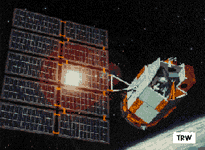Lewis
Part of the SSTI program
 Lewis was selected in the NASA SSTI (Small
Spacecraft Technology Initiative) program, along with Clark, to demonstrate advanced spacecraft technologies. Contract start was July 11, 1994.
Lewis was selected in the NASA SSTI (Small
Spacecraft Technology Initiative) program, along with Clark, to demonstrate advanced spacecraft technologies. Contract start was July 11, 1994.
Spacecraft
3-Axis stabilized, zero momentum biased control system with 0.004 deg knowledge. Single solar array generates 600W power at 1 year. Hydrazine propulsion system with eight 1-lbf thrusters. System reliability is 0.86 at 5 years. Ground stations: primary at TRW, Chantilly VA, receive only at Univ. Alaska, Fairbanks, Stennis Space Center, MS, HBCU network. Data archive by Stennis Space
Center, accessible on Internet, T1 line.
Payload
Earth imaging Hyperspectral Imager (HSI) with 384 bands (0.4 - 2.5 Ám, 30 m pixels, 7.7 km swath, panchromatic: 0.45 - 0.75 Ám, 5 m pixels, 13 km swath). Linear Etalon Imaging Spectral Array (LEISA), from NASA GSFC (1.0 - 2.5 Ám, 256 channels, 300 m pixels, 77 km swath). Ultraviolet Cosmic Background (UCB), from UC Berkely (35 - 85 nm). In addition to the above instruments, several spacecraft systems technologies will be flown. A partial list of planned technology demonstrations is: pulse tube cryocooler, solid state recorder, fiber optic data bus, GPS attitude determination, wide FOV star tracker, magnetically suspended reaction wheel, lightweight structure with integrated thermal control, GFRP overwrapped propellant tank.
| Country of Origin | United States |
| Customer/User | NASA |
| Manufacturer(s) | TRW |
| Size | 36.5 in. hex by 69.5 in. |
| Launch | Currently slated for May 1997 on a Lockheed Martin Launch Vehicle (LMLV) |
| Orbit | 523 km, circular, sun synchronous |
| Design Life | 3 years (required life is 1 year) |
| Related Sites |
Information in The Mission and Spacecraft Library is provided without warranty or guarantee. USE AT YOUR OWN RISK.